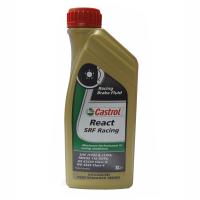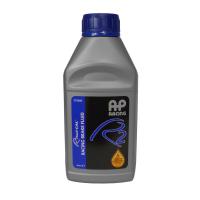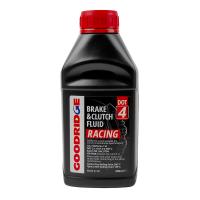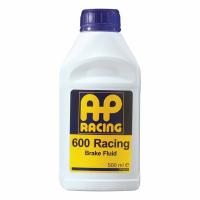Brake Fluids
What's the difference between Glycol and Silicone based brake fluids?
Brake fluid is the precious fluid in a brake system. This brake fluid is the solid / physical connection delivering the force you exert on the brake pedal to the brake calipers. The basic premise is the brake fluid is non compressible thus being able to exert the correct force through the brake lines and to the calipers.
One of the enemies of brake fluid is heat!! If enough heat is transferred into the fluid and is able to boil the fluid this will result in brake fade. Also leaks and air in the system will result in the pedal travelling to far and loose the pressure you have generated to stop the car.
A very important thing to keep in mind is when you purchase brake fluid they are not all the same. You can get Poly/Glycol Ethylene and Silicon based.
GLYCOL BASED BRAKE FLUID:
Glycol based brake and clutch fluid is that most commonly used within the motor industry. The key ingredient Glycol Ethylene has high lubrication properties to lubricate the rubber parts. However this ingredient is not susceptible to boiling.
Glycol based brake fluid is hygroscopic meaning it has the ability to mix with water and still perform adequately. In fact, it will absorb a tiny amount of water from the moment it has been manufactured and nothing can be done to stop this. A certain amount of Glycol will absorb a certain amount of moisture within a certain time frame. Hence why road car manufacturers recommend changing brake fluid at suggested timed intervals
This absorbed moisture will drastically reduce the boiling point of the fluid. In a passenger car this is not a problem however in a race car it is a major issue, due to the boiling point decreasing, the performance ability will also decrease. Hence why Glycol brake fluids have dry boiling points and wet boiling points, dry for when new, wet for when some moisture has been absorbed.
SILICONE BASED BRAKE FLUID:
The other option is Silicon based fluid. This type of fluid is non-hygroscopic, meaning it does not absorb any water. Often used in classic and vintage cars and military type vehicles because silicone based brake fluid will not corrode internal brake parts nor will it damage paint work. An added bonus when used in some show cars.
This type of fluid is more compressible and can give the driver a feeling of a spongy pedal.
Silicone based brake fluid has not been developed for, or intended for, use in race applications.
IN SUMMARY:
Glycol based brake fluids are two times less compressible than Silicone based fluids. Less compressibility of the brake fluid will increase pedal feel. Changing the brake fluid in a race car on a regular basis will greatly increase the performance of the brake system.
Brake fluids are rated by the DOT specification. The most important characteristic of any brake fluid when used in a race car is the boiling point. A high boiling point is necessary for racing applications due the massive heat build up in the rotors that is transferred through the calipers to the brake fluid.
The maximum boiling point is important when selecting a fluid for a race car the minimum dry boiling point should be 250°C or higher if possible. The standard DOT type fluids are not really adequate.
Brake Fluid Type Dry Boiling Point Wet Boiling Point
Dot 3 205°C (401°F) 140°C (284°F)
Dot 4 230°C (446°F) 155°C (311°F)
Dot 5 260°C (500°F) 119°C (246°F)
Dot 5.1 270°C (518°F) 190°C (375°F)
WET BOILING POINT: The minimum temperature that the brake fluid will boil when the fluid has 3% water by volume of the system
DRY BOILING POINT: The temperature that brake fluid will boil with no water present in the system
It is always best to use the correct and race specific brake fluids in your race car. These are the brake fluids we stock here at Merlin Motorsport.
CASTROL REACT SRF. The SRF is the absolute best brake fluid on the market. If you want the best the Castrol SRF is it. Due to it's extremely high dry & wet boiling points.
Dry Boiling Point: 310°C (590°F)
Wet Boiling Point: 270°C (518°F)
GOODRIDGE RACING DOT 4 BRAKE FLUID. Goodridge Racing brake fluid has been designed for all levels of race use, from grass roots to vehicles competing at the highest level. Compatible with DOT 3 and DOT 4 car and motorcycle brake systems.
Dry Boiling Point: 312°C (594°F)
Wet Boiling Point: 204°C (399°F)
AP RACING 600 BRAKE FLUID. AP 600 Fluid has been developed for racing applications where higher than normal temperatures are being experienced, e.g. when using carbon/carbon discs and the ultimate in brake fluid performance are required.
Dry Boiling Point: 312°C (594°F)
Wet Boiling Point: 204°C (399°F)
MILLERS RACING BRAKE FLUID 300 PLUS. Millers 300 Plus Racing Brake fluid is designed for racing and high performance use where high temperatures are experienced. Similar in characteristics to AP 600 brake fluid.
Dry Boiling Point: 310°C (590°F)
Wet Boiling Point: 202°C (395°F)
VP RACING 622 RACING BRAKE FLUID. A fully synthetic brake fluid rated to DOT 4. 622 Racing Brake Fluid maintains stability under high temperatures, lap after lap.
Dry Boiling Point: 310°C (590°F)
Wet Boiling Point: 204°C (399°F)
GOODRIDGE PERFORMANCE DOT 4 BRAKE FLUID. Designed for fast road and trackday use. Compatible with DOT 3 and DOT 4 braking systems. Has a high boiling point when compared to OEM brake fluids.
Dry Boiling Point: 269°C (516°F)
Wet Boiling Point: 159°C (318°F)
AP RACING 551 BRAKE FLUID. AP 551 brake fluid is suitable for most forms of motorsport where a DOT 3 specification is recommended, but has a higher boiling point than similar DOT 3 brake fluids intended for road use.
Dry Boiling Point: 275°C (527°F)
Wet Boiling Point: 151°C (304°F)
CASTROL REACT PERFORMANCE BRAKE FLUID. Castrol React Performance DOT 4 brake fluid (formerly known as Castrol Response Super DOT 4 brake fluid) has been formulated for use in high performance brake and clutch systems in fast road and competition alike. Specifically designed as a high temperature alternative to DOT 5.1 rated fluids.
Dry Boiling Point: 260°C (500°F)
Wet Boiling Point: 190°C (374°F)
AUTOMEC SILICONE BRAKE FLUID. Available in either 500ml or 1 litre bottles, Automec Silicone brake fluid complies to DOT 5 specification. Unlike standard polyglycol based fluids, this silicone based fluid repels water and so never needs changing and also maintains the high boiling point of 260°C throughout the life of the product. Primarily used for classic or vintage cars which are often stored for long periods, not intended for racing use.
Dry Boiling Point: 260°C (500°F)
TOP TIPS.
It is imperative you bleed your brakes before every event. Most top race teams remove the old fluid and replace it with new before each race. Doing this is the only way you can be 100% sure the fluid have not absorbed any water and you will get the best performance out of your brakes.
It is also a good idea not to buy fluid in large containers and when the fluid is exposed to the atmosphere make sure it is for the shortest time possible.
WHAT YOU ‘SHOULD DO’ AND ‘NEVER DO’ WITH RACE CAR BRAKE FLUID!
• Never use standard Silicon based fluid in a race car brake system.
• Using racing specific brake fluid will increase brake performance.
• Never mix different types or brands of brake fluid.
• Use small fluid containers that can be used quickly.
• Always make sure the reservoir tops are tightly secured.
• Purge the system (drain completely) and replace fluid often.
• Immediately replace the reservoir cap after any maintenance. Always bleed brakes before all events.








